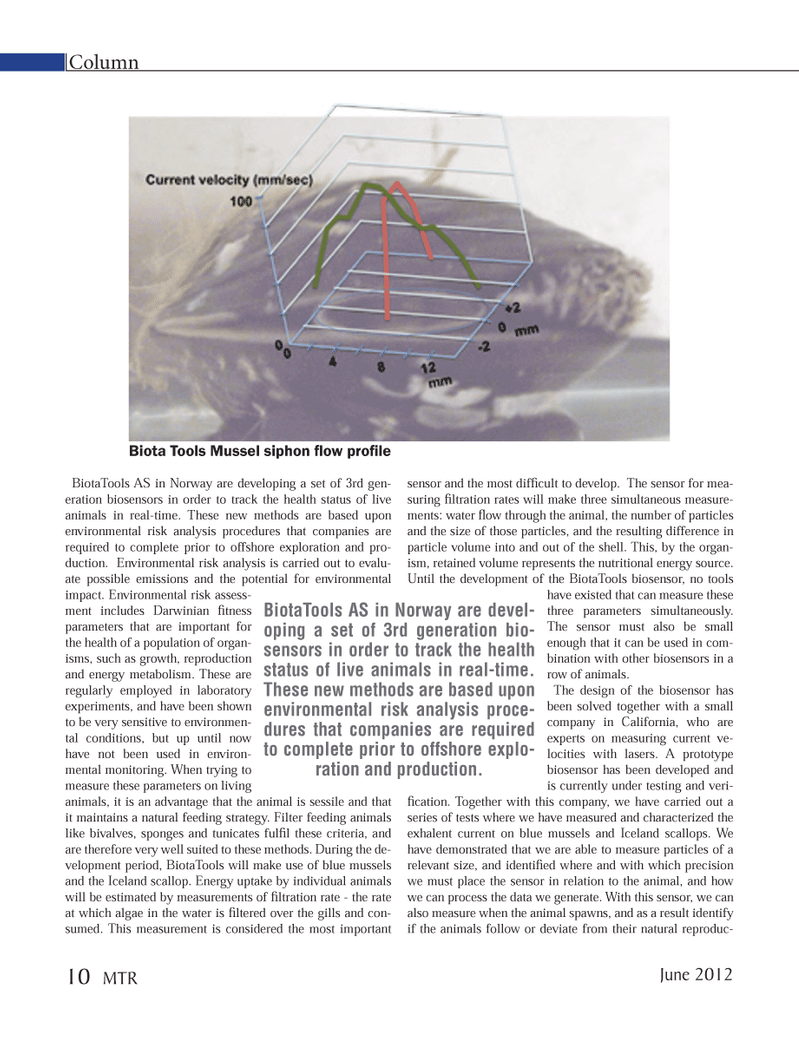
Page 10: of Marine Technology Magazine (June 2012)
AUV Arctic Operations
Read this page in Pdf, Flash or Html5 edition of June 2012 Marine Technology Magazine
BiotaTools AS in Norway are developing a set of 3rd gen- eration biosensors in order to track the health status of live animals in real-time. These new methods are based upon environmental risk analysis procedures that companies are required to complete prior to offshore exploration and pro- duction. Environmental risk analysis is carried out to evalu- ate possible emissions and the potential for environmental impact. Environmental risk assess- ment includes Darwinian Þ tness parameters that are important for the health of a population of organ- isms, such as growth, reproduction and energy metabolism. These are regularly employed in laboratory experiments, and have been shown to be very sensitive to environmen- tal conditions, but up until now have not been used in environ- mental monitoring. When trying to measure these parameters on living animals, it is an advantage that the animal is sessile and that it maintains a natural feeding strategy. Filter feeding animals like bivalves, sponges and tunicates fulÞ l these criteria, and are therefore very well suited to these methods. During the de- velopment period, BiotaTools will make use of blue mussels and the Iceland scallop. Energy uptake by individual animals will be estimated by measurements of Þ ltration rate - the rate at which algae in the water is Þ ltered over the gills and con- sumed. This measurement is considered the most important sensor and the most difÞ cult to develop. The sensor for mea- suring Þ ltration rates will make three simultaneous measure- ments: water ß ow through the animal, the number of particles and the size of those particles, and the resulting difference in particle volume into and out of the shell. This, by the organ- ism, retained volume represents the nutritional energy source. Until the development of the BiotaTools biosensor, no tools have existed that can measure these three parameters simultaneously. The sensor must also be small enough that it can be used in com-bination with other biosensors in a row of animals. The design of the biosensor has been solved together with a small company in California, who are experts on measuring current ve- locities with lasers. A prototype biosensor has been developed and is currently under testing and veri- Þ cation. Together with this company, we have carried out a series of tests where we have measured and characterized the exhalent current on blue mussels and Iceland scallops. We have demonstrated that we are able to measure particles of a relevant size, and identiÞ ed where and with which precision we must place the sensor in relation to the animal, and how we can process the data we generate. With this sensor, we can also measure when the animal spawns, and as a result identify if the animals follow or deviate from their natural reproduc- Column Biota Tools Mussel siphon ß ow pro Þ leBiotaTools AS in Norway are devel- oping a set of 3rd generation bio-sensors in order to track the health status of live animals in real-time. These new methods are based upon environmental risk analysis proce-dures that companies are required to complete prior to offshore explo-ration and production.June 201210 MTRMTR #5 (1-17).indd 10MTR #5 (1-17).indd 105/31/2012 2:00:31 PM5/31/2012 2:00:31 PM

 9
9

 11
11
